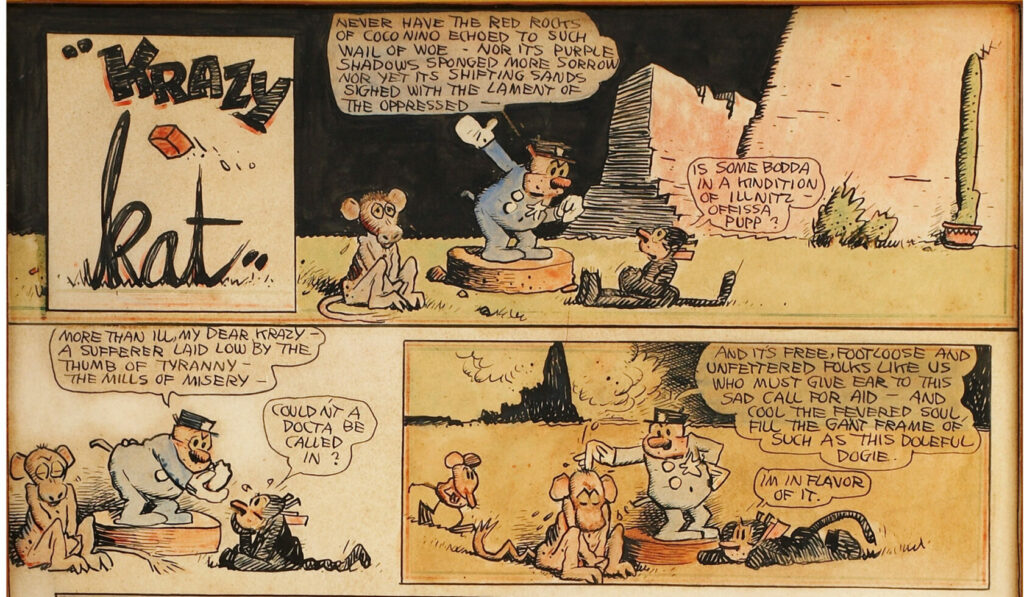Krazy Kat by George Herriman.
In 1910, a mouse named Ignatz first beaned Krazy Kat with a brick. The plot of this comic strip, centered on a “heppy go lucky kat,” is simple. Krazy Kat loves Ignatz Mouse. Officer Pup loves Krazy Kat. Ignatz Mouse hits Krazy over the head with a brick; Officer Pup pursues and usually arrests Ignatz Mouse; Krazy, to whom the brick seems to be a sign of love, is ecstatic. A small heart pops up above his head. The cartoonist, George Herriman, twisted and tangled the three-lover triad and cat-mouse-dog triad and spent thirty-one years retying the same surreal knot. You know what will happen in any strip of Krazy Kat—the same sequence reoccurs eternally—but somehow there is still room for unexpected delight.
E. E. Cummings was one of the Kat’s biggest fans. In 1922, he wrote from Paris to request clippings from friends in America. (“Thank you moreover for a Kat of indescribable beauty!” he wrote to an obliging friend.) In his 1946 introduction to the first edition of the collected strips, Cummings wrote that the brick unleashed joy within the “ultraprogressive game” of the real world, with its preestablished rules, of which it flouted the most sacred: “THOU SHALT NOT PLAY.” (Winnicott defines play as “the continuous evidence of creativity, which means aliveness.”) Herriman gives pleasure without the instant gratification of a punch line, undercutting the expected gag trajectory. The brick hurtling across the page doesn’t end the joke; games end, but play is infinite. There is no winner, and if there is, it is Krazy, who, for private reasons, interprets the brick as love.
The strips were published daily in Hearst newspapers between 1913 and 1944, but Herriman never repeated himself. Or at least, the strip didn’t look the same. The improbable landscape of Coconino County, Arizona, where the strip is set, seems almost to move on the page. Bill Watterson, the creator of Calvin and Hobbes and a Herriman megafan, wrote, “Mountains are striped. Mesas are spotted … The horizon is a low wall the characters climb over … The moon is a melon wedge, suspended upside down.” Herriman juggled all the elements the form allowed: language (hyperbolic Creole, Spanish, Yiddish); comedy (existential, vaudevillian, burlesque); and gender—the Kat is neither he nor she, but rather, as Herriman put it, “a pixie,” whose pronouns switch within a strip and occasionally within a sentence, making the possible configurations and miscommunications of the comic infinite. Somehow, in this static form, nothing is inanimate. Only a killjoy would try to extract too much meaning from Krazy Kat, but it’s not surprising that Herriman created art that depended on fluid identities. Twenty-seven years after Herriman died, the sociologist Arthur Asa Berger published the birth certificate on which Herriman was registered as “col,” for “colored.” Herriman was born in New Orleans in 1880 to a mixed-race family that moved to Los Angeles ten years later and from then on passed as white. Herriman had plenty of reasons to keep it up, including his job at the Los Angeles Examiner, a publication that regularly outed people for their race, and the fact that he lived with his white wife in a neighborhood with racist housing covenants. Telling different stories at different times, Herriman explained his light brown skin as the result of years spent living under the Greek sun to some people and claimed various ancestries—often French—to others. (As Krazy tells Ignatz, “Lenguage is that we may mis-unda-stend each udda.”)
Copyright
© The Paris Review












